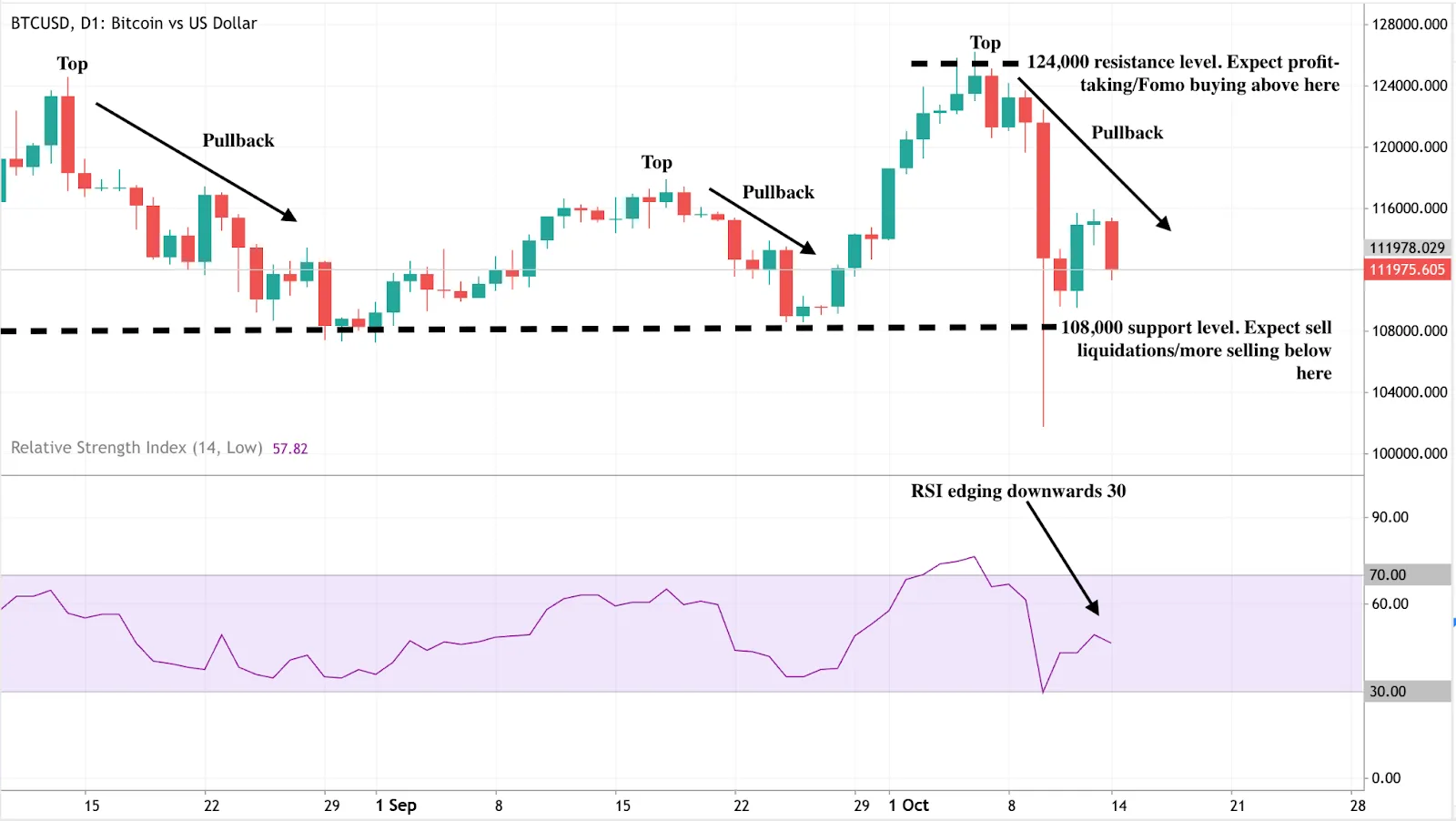Was the $19 billion Bitcoin price sell-off just a setup for a late-2025 bull run?
Was the $19 billion Bitcoin price sell-off just a setup for a late-2025 bull run?
Was the $19 billion Bitcoin price sell-off just a setup for a late-2025 bull run?

Analysts suggest Bitcoin’s dramatic $19 billion October liquidation may have been a market fakeout rather than the start of a prolonged downturn. The coin’s quick recovery from $107,000 to $116,000, alongside signs of stabilising macro conditions and stronger institutional flows, points to a short-term shakeout before a potential Q4 2025 breakout. The key test now is whether Bitcoin can reclaim $125K and sustain momentum towards $150K in the months ahead.
Key takeaways
- $19 billion in crypto liquidations were triggered by Donald Trump’s tariff threat on China.
- Bitcoin rebounded 8% within days as trade tensions de-escalated.
- Analyst Ash Crypto’s projection of a dip to $106K followed by a surge toward $150K remains valid.
- Institutional inflows are strengthening, while retail traders remain hesitant.
- Volatility resets are creating opportunities for traders who use disciplined risk management strategies such as stop-loss orders.
Bitcoin market crash 2025: The $19B liquidation and rebound
October’s sell-off ranks among Bitcoin’s sharpest corrections since 2024. A sudden 100% tariff declaration from President Trump on Chinese imports rattled global markets, leading to mass liquidations of leveraged crypto positions. Bitcoin briefly fell to $107K, while Ethereum dropped below $3,500, wiping out billions across exchanges.
Even stablecoins weren’t spared - USDe depegged to $0.65 on Binance before stabilising. Once Trump softened his rhetoric and U.S. Treasury Secretary Scott Bessent confirmed a “substantial de-escalation” in talks with Beijing, risk appetite returned. By Monday, Bitcoin had climbed back above $116K, showing that institutional demand was intact despite the volatility.
Bitcoin price prediction: Ash Crypto’s outlook
Market analyst Ash Crypto accurately predicted the October downturn, forecasting that Bitcoin would retreat to $106K and Ethereum to around $3,800. Both targets materialised, fulfilling the first half of his prediction.

He now believes the correction marks a “fakeout before the breakout”, with Bitcoin positioned to reach $150K by year-end, potentially fuelling an altcoin rally.
Ash says he’s currently 85% exposed to the market, keeping 15% in reserve capital to capitalise on any further dips. He expects a rebound to accelerate in the final 10 days of October, consistent with the seasonal “Uptober” trend historically associated with Q4 recoveries.
Bitcoin Institutional investment vs. retail hesitation
Institutions continue to play an outsized role in this cycle. While retail sentiment remains cautious, major financial firms are scaling up their crypto exposure:
- Morgan Stanley is expanding its digital asset offerings through its E-Trade division.
- JPMorgan continues to build its stablecoin infrastructure, even as CEO Jamie Dimon reiterates scepticism about Bitcoin.
- Invesco’s Chris Mellor calls Bitcoin a “digital gold” alternative, noting its low correlation with equities.
- DeVere Group’s Nigel Green says volatility in crypto has become “productive”, reflecting deeper liquidity and maturity.
Meanwhile, Hargreaves Lansdowne warns retail clients that Bitcoin remains “too volatile for growth portfolios,” highlighting an ongoing divide between institutional confidence and retail caution.
Crypto market outlook Q4 2025: Fakeout pattern and market psychology
Analysts say Bitcoin’s recent price action mirrors historical fakeout structures - where steep declines flush out over-leveraged traders before a strong reversal.
Historical patterns support this view:
- In 2020, Bitcoin fell 20% before rallying to $60K.
- In 2023, a similar 22% pullback was followed by record-breaking highs.
Such shakeouts typically mark the transition from fear to accumulation, as long-term holders strengthen their positions. According to Ash Crypto, when pessimism peaks, markets often stage their sharpest reversals - a dynamic that could define the remainder of 2025.
Bitcoin technical analysis 2025:
As of now, bears retain control on the daily chart, even after Bitcoin’s rebound from $107K. Price action shows signs of a developing triple-top pattern - a bearish formation that could suggest trend exhaustion.
The Relative Strength Index (RSI) continues to edge lower toward 30, signalling waning buying power and rising selling pressure.
A decisive break below $108,000 could confirm the triple-top and trigger another round of sell-offs. On the flip side, if buyers manage to push prices higher, resistance around $124,000 could serve as the next major barrier before a potential retest of $125K–$150K levels.

How to trade Bitcoin’s volatility on Deriv platforms
Bitcoin’s price swings create trading opportunities on Deriv MT5 (DMT5) - a powerful platform for crypto, forex, and synthetic markets.
Traders can use stop-loss and take-profit orders to manage positions automatically during high-volatility periods. The platform’s customisable charts and access to multiple asset classes - including Gold, Ethereum, and major forex pairs - allow for effective intermarket analysis.
For those seeking exposure to crypto-like volatility without external news risk, Derived Indices offer a smart alternative. These synthetic markets simulate real-world market dynamics and trade 24/7.
Traders can also use Deriv’s trading calculators to estimate margin, pip value, and potential profit or loss before entering a position - essential tools for precise risk management.
Bitcoin Investment implications
For traders, the current structure points to a market reset rather than a trend reversal.
- Short-term strategies could involve buying near $110K–$112K while watching for a confirmed breakout above $125K.
- Medium-term investors may focus on accumulation strategies, anticipating that institutional flows and declining leverage could strengthen Bitcoin’s price floor.
If these projections hold, the October fakeout might be remembered as the turning point before Bitcoin’s next major advance toward its 2025 highs.
The performance figures quoted are not a guarantee of future performance.















